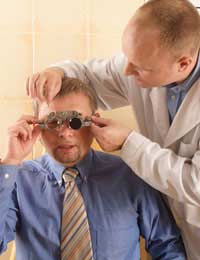Nystagmus

Nystagmus is a disorder of the eye that can lead to visual loss, sometimes even virtual blindness.
It is characterised by involuntary movements of the eye, most often causing the eye to move side to side, but in some cases up and down and more rarely in a circular fashion.
If diagnosed in childhood, the person can often adapt quite easily to the condition but for those diagnosed later in life, the effects can be very disruptive to every day life and can be come quite difficult to live with.
What Causes Nystagmus?
Nystagmus can be diagnosed very early in childhood and is thought to be caused by a problem in communication between the brain the eye, or as a result of another condition such as glaucoma, cataracts or some retinal conditions. It is also possible for the condition to be inherited and in this instance the actual and initial cause may remain unknown.
If a child has been diagnosed early on with this complaint, it is often beneficial to them to provide them with as much information as possible, told in the right type of language aimed at the right level of comprehension, to allow them to understand the problem.
For those who are diagnosed later in life, it can be an indication of a more serious health problem as it has been associated with neurological conditions, stroke or even because of a trauma to the head.
Signs and Symptoms
Nystagmus that has a sudden onset may often be due to a blow to the head and the cause will be quite obvious, for others they may not be aware initially of the problem and will only notice after some else has witnessed the involuntary eye movements or because their sight is failing. Many people with nystagmus will become short sighted, often so much so that sight can become significantly compromised.The severity and speed of deterioration of the condition will depend of the cause of the nystagmus, if it is diagnosed in early childhood it tends to remain stable and not deteriorate very quickly, if at all.It is very important to acquire an accurate diagnosis by a trained professional as soon as any symptoms are experienced as any underlying conditions will need diagnosing and treating as soon as possible.
Treatment Options
Although nystagmus cannot be cured, there are a range of options available to help treat the symptoms. Glasses, contact lenses and other visual aids may be beneficial to the sufferer and help correct the long or short sightedness.
Very occasionally surgery may be recommended to help and adjust the position of the muscles of the eye, though this may not cure the problem altogether.
Experts are currently investigating the options of trying to retrain the eye by finding ways of allowing the person to become more controlled over the problem and try and re-establish power and control over the movements.
It is most important however to find out the underlying cause of the condition and treat this as soon as possible and as effectively as possible as it may be caused by a life threatening condition.
Nystagmus is not a contagious problem and cannot be transmitted in anyway, it is not caused by infections or viruses but is potentially dangerous until the cause of the complaint is discovered and managed.
- Rosacea in the Eye
- Is a Vitreous Haemorrhage Serious?
- My Mum Has Macular Degeneration
- What is Vitrectomy Surgery?
- Why Do Eyelids Twitch?
- What is Graves' Ophthalmology?
- Retinal Vein Occlusion
- Retinitis Pigmentosa
- Corneal Disease
- Corneal Ulcers
- Flashes and Floaters
- Keratoconus
- Double Vision
- Eye Infections
- What Causes Dry Eye?
- Diabetes and Eyes
- Hay Fever and Allergies


Re: Contact Lens Trials Explained
Hi Please could you put me in touch with your wholesale/distribution department. Which countries do you currently…
Re: What is Vitrectomy Surgery?
I had vitrectomy 4 weeks ago. The surgery was not well done as apparently bleeding occurred. The hole did not close despite having…
Re: Glasses or Contacts?
I need a eye exam and new glasses it's been since 2013/ I have no income I lost my boyfriend last September and I've been homeless ever…
Re: Eyewear for the Partially Sighted
This extract from your text is not clear and the grammar is poor- and the letters in the validation box are mixed…
Re: Eye Cancer Symptoms
I have yellow in both eyes lools like 2 dots. But looks like its makin the white part of my eye yellow whats wrong with me
Re: Are my Glasses Affecting my Eyes?
Hi, Please can anyone give advice on wearing varifocals. After a short while I develop a severe ache in my left eye and…
Re: Are my Glasses Affecting my Eyes?
On wearing my new varifocals, I am finding that my left eyeball hurts so much it feels like it will explode after 15…
Re: What is the Cause of my Itchy Eye?
I have One and only One itchy eye that has been going on 24/7 for 5 weeks.Eye is not swollen vision not affected. Eye doc…
Re: Contact Lens Trials Explained
Hi, We wanted to get in touch with you to increase traffic on your website. Please reply to this email so we can send you free…
Re: What Are Photoreceptors?
I have a 10 year old grandson who was diagnosed at apx 2 with cone and rod dystrophy eye disease. Please help with any treatment…